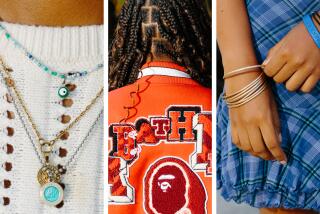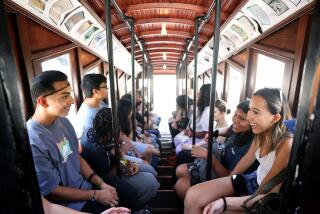Japan, U.S. Teens Share Slices of Life and Pizza
- Share via
The miles that separate Fukuoka, Japan, and Santa Monica seemed less formidable Monday after students from Oki Gakuen and St. Monica high schools met and discovered some common interests: music, sports, pizza and Coca-Cola.
“They’re just typical teen-agers--just from a different place, a different part of the world,” St. Monica senior Kathy Bailey said of the Japanese visitors.
About 45 students from Oki Gakuen High School in Fukuoka spent the day at St. Monica High School in Santa Monica getting a glimpse of student life in America.
They toured the school, watched scenes from the school play, “Frankenstein,” ate a lunch of pizza and submarine sandwiches, danced to the latest rap music at a sock hop held in their honor and played volleyball against the seniors.
“This will help broaden their eyes,” said Toshiyuki Yoshinaga, an English teacher at Oki Gakuen.
For the last three years, students from Oki Gakuen have visited St. Monica and other Catholic schools in Los Angeles. This year, 650 will visit 15 schools in Los Angeles County.
The students have to pay their own way, $1,400 each, but teachers on both sides believe that the experience outweighs the cost.
“God knows we need more opportunities to create understanding between people, and this certainly does that,” said Teresa Dickey, English teacher at St. Monica.
Students who have taken Dickey’s world literature class have read some Japanese literature. The day was a day of cultural sharing, Dickey said, and it was full of surprises.
“They go to school from Monday through Saturday, 7:30 to 4:30,” said Stephanie Teves of her Japanese friends. “That’s wild.”
Masaru Tomohara, 17, seemed equally surprised to learn that schools in this country are co-ed.
“I think its good. It looks fun,” he said with a smile.
The trip to the United States was the first for teacher Yoshinaga, as well as the students. He was struck by the openness of the U.S. schools, the open-minded attitudes of the students and the lack of formality.
“Those things are impressive for the student, and they are going to remember,” Yoshinaga said, adding that Japanese schools need to “move in that direction.”
Sitting around a table during lunch, Stephanie got a quick lesson in origami, a Japanese form of paper art. Carefully following the motions of her partner, Masako Yamashito, Stephanie folded a small square of red and white paper.
“See, it doesn’t look like yours,” she said, surveying her finished creation.
Masako laughed, holding her neatly folded origami bird next to her partner’s one.
“She’s laughing at me, . . . that’s not a good sign,” Stephanie said with a playful grin.
Although neither group was adept at speaking the other’s language, the students quickly learned to communicate. In place of words, they used hand gestures, head nods and lots of smiles and laughs.
“When they get one on one, it’s an international language,” said Sister Cheryl Milner, principal of St. Monica. “They come away changed.”
Julio Quinteros, captain of the football team, said he had no problem communicating with his partner, Hidekazu Fujiki, 17.
“I guess it’s because he’s an athlete too. We understand each other,” he said.
Hidekazu is a black belt in judo.
David Martinez even got an opportunity to practice his Japanese. Under the watchful eye of his partner, Masaru, he carefully tried his hand at counting in Japanese.
More to Read
Sign up for Essential California
The most important California stories and recommendations in your inbox every morning.
You may occasionally receive promotional content from the Los Angeles Times.










